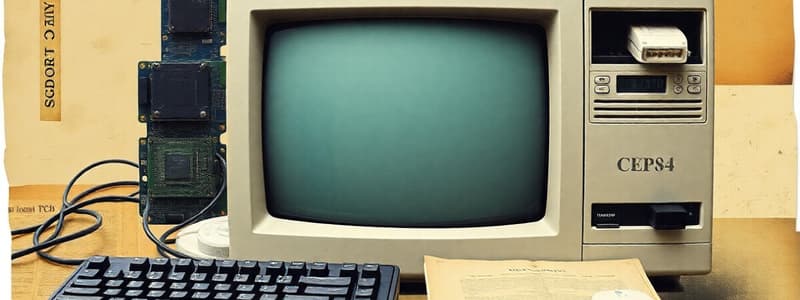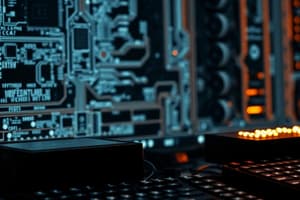Podcast
Questions and Answers
What is the smallest unit of data in computing?
What is the smallest unit of data in computing?
How many bits are in a byte?
How many bits are in a byte?
Which of the following is considered an output device?
Which of the following is considered an output device?
Which device is primarily used for inputting text?
Which device is primarily used for inputting text?
Signup and view all the answers
What does GHz stand for in computer processing speed?
What does GHz stand for in computer processing speed?
Signup and view all the answers
Which factor affects a personal computer's overall speed?
Which factor affects a personal computer's overall speed?
Signup and view all the answers
What is the function of a microphone in a computer system?
What is the function of a microphone in a computer system?
Signup and view all the answers
For which of the following components does a faster speed result in better performance?
For which of the following components does a faster speed result in better performance?
Signup and view all the answers
What is the primary role of an output device?
What is the primary role of an output device?
Signup and view all the answers
What is the primary function of a scanner in a computer system?
What is the primary function of a scanner in a computer system?
Signup and view all the answers
How many bits are combined to form a byte?
How many bits are combined to form a byte?
Signup and view all the answers
What does a 1.2 GHz chip's speed indicate compared to a 400 MHz chip?
What does a 1.2 GHz chip's speed indicate compared to a 400 MHz chip?
Signup and view all the answers
Which of the following correctly defines the term 'Hertz'?
Which of the following correctly defines the term 'Hertz'?
Signup and view all the answers
What happens if the CPU speed is significantly higher than the bus speed?
What happens if the CPU speed is significantly higher than the bus speed?
Signup and view all the answers
Which statement is true about a printer as an output device?
Which statement is true about a printer as an output device?
Signup and view all the answers
What denotes a 'mega' prefix in terms of Hertz?
What denotes a 'mega' prefix in terms of Hertz?
Signup and view all the answers
Which output device would you use for audio playback?
Which output device would you use for audio playback?
Signup and view all the answers
What is represented by a binary digit?
What is represented by a binary digit?
Signup and view all the answers
What determines the size of a file on a computer?
What determines the size of a file on a computer?
Signup and view all the answers
Study Notes
Computer Components
- A computer is an electronic device that operates using software (instructions) stored in memory. It takes input data, manipulates it, and produces output information.
Hardware
-
Hardware refers to the physical components of a computer system, including the personal computer (PC).
-
Key hardware categories:
- Central Processing Unit (CPU): The control unit fetches and decodes instructions, while the Arithmetic Logic Unit (ALU) performs calculations.
- Main Memory (RAM): This volatile memory holds instructions and data while the program is running.
- Secondary Storage Devices: Non-volatile storage like hard drives, CDs, DVDs, and flash drives.
- Input Devices: Send information to the computer, including keyboards, mice, digital cameras, and microphones.
- Output Devices: Send information from the computer to the outside, including monitors, printers, speakers, and headphones.
-
Examples of output devices include inkjet and laser printers. Inkjet printers are affordable and produce high-quality color prints quickly. However, laser printers are faster, produce higher-quality output, and are more expensive.
CPU's Role
- The Central Processing Unit (CPU) cycles through three steps to run a program:
- Fetch: retrieves the next instruction from memory.
- Decode: interprets the instruction and creates a signal.
- Execute: sends the signal to the appropriate component to perform the operation.
Main Memory
- Main memory (RAM) holds instructions and data for the CPU.
- Volatile memory, meaning the content is lost when the computer powers off.
- Also referred to as random access memory (RAM).
Main Memory Organization
- Bit: The smallest piece of memory. It has two values (0 or 1).
- Byte: 8 consecutive bits.
- Word: Usually 4 consecutive bytes (with an address).
- Computers use binary language (0s and 1s). A unique combination of 8 bits defines a character or symbol.
Secondary Storage
- Non-volatile storage - data remains even when the computer is turned off. This includes hard drives, CDs, DVDs and flash drives.
Input Devices
- Used to send information to the computer, examples: keyboard, mouse, digital cameras, disk drives, CD/DVD drives, microphones, and scanners.
Output Devices
- Used to send information from the computer to the outside, examples: monitors, printers, speakers, headphones, projectors, GPS systems, and CD/DVD recorders, and USB flash drives.
Computer Speed
- Measured in megahertz (MHz) or gigahertz (GHz).
- The clock speed indicates how quickly computations are performed in RAM. A faster clock speed generally indicates faster processing.
Computer Speed (categories)
- Mainframe: supports many simultaneous users and programs.
- Supercomputer: designed to perform complex calculations rapidly.
- Embedded: Self-contained and specially designed for a specific function (e.g. thermostat).
- Personal computers: general-purpose for single users.
- Smartphone: versatile devices with numerous applications, cameras and web connectivity.
Software
- Instructions that enable a computer to execute tasks.
- Divided into operating system software and application software.
- Operating system software: manages computer hardware and programs, enabling multitasking and single-user or multi-user operation (e.g., MS-DOS, UNIX, Windows).
- Application software: enables specific tasks like writing letters, browsing the Internet, or drawing pictures, depending on the operating system's instructions (e.g., word processors, web browsers or video games.)
- Programs are a set of instructions that direct computers to perform tasks.
- Programs are written using programming languages.
Studying That Suits You
Use AI to generate personalized quizzes and flashcards to suit your learning preferences.
Related Documents
Description
This quiz covers the essential components of a computer, including hardware categories such as the CPU, RAM, and storage devices. Learn about input and output devices as well as their functions within a computer system. Perfect for students interested in computer science and technology.




